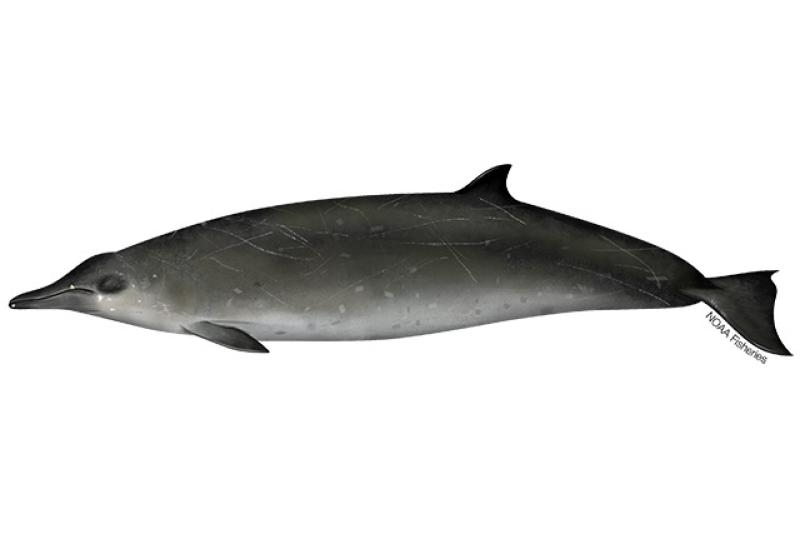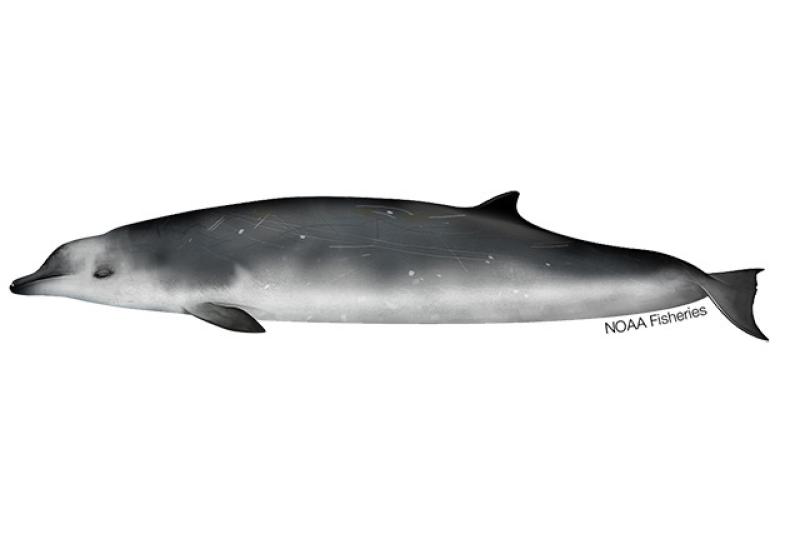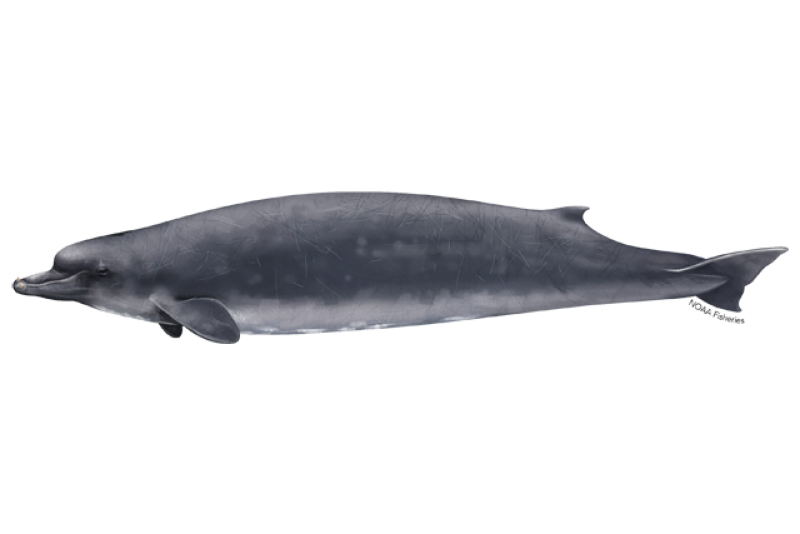Longman's Beaked Whale
Indopacetus pacificus
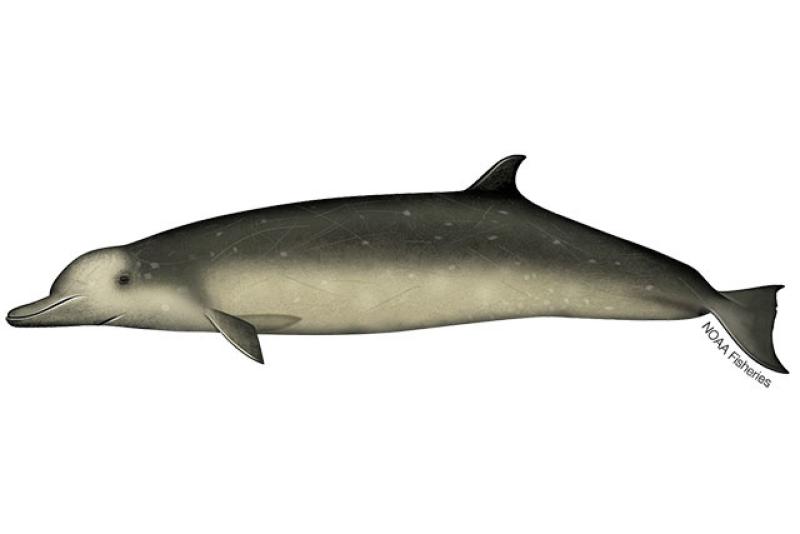
Protected Status
Quick Facts
 The setting sun highlights the puffy blows characteristic of Longman's beaked whale. Credit: NOAA Fisheries
The setting sun highlights the puffy blows characteristic of Longman's beaked whale. Credit: NOAA Fisheries
The setting sun highlights the puffy blows characteristic of Longman's beaked whale. Credit: NOAA Fisheries
About the Species
 The setting sun highlights the puffy blows characteristic of Longman's beaked whale. Credit: NOAA Fisheries
The setting sun highlights the puffy blows characteristic of Longman's beaked whale. Credit: NOAA Fisheries
The setting sun highlights the puffy blows characteristic of Longman's beaked whale. Credit: NOAA Fisheries
Longman's beaked whales, sometimes known as "tropical bottlenose whales" or "Indo-Pacific beaked whales," are one of the rarest and least known members of the beaked whale family. They generally live in warm, deep, pelagic waters of tropical and subtropical regions in the Indian and Pacific Oceans. Until recently, this species was only known and described from two skulls found on beaches. The first skull was found in Australia in 1882 and described by H.A. Longman—their namesake—in 1926; the second skull was discovered in Africa in 1955. In the early 2000s, genetic and morphological information were used to link these skulls with more specimens of individuals that washed ashore and at-sea sightings, thereby providing a more complete description of Longman’s beaked whales as a species.
Longman’s beaked whales are larger than most other beaked whale species and have other discernible physical characteristics that make them relatively easy to identify if spotted in the wild, such as a large pronounced melon and a distinct black band extending from behind the blowhole to the pectoral flippers. Little is known about the life history and ecology of this species. Most sightings in U.S. waters have been made offshore of the Hawaiian Islands.
Although they face threats from entanglement in fishing gear and human-caused noise, Longman’s beaked whales in the United States are not endangered or threatened. Like all marine mammals, they are protected under the Marine Mammal Protection Act.
Population Status
There is little information on the abundance and population structure of this species worldwide due to the rarity of sightings at sea. An estimate of the population size for the U.S. stock in Hawaiʻi can be found in the NOAA Fisheries’ stock assessment reports. A stock is a group of animals that occupy the same area and interbreed. However, data are insufficient to estimate trends in population size of Longman’s beaked whales in Hawaii.
Appearance
Longman's beaked whales have a large, robust body with a fairly large, hooked dorsal fin located behind (caudal to) the midpoint of their back. This species has dark, small, rounded, narrow flippers that fit into a depression on either side of the body. They have a well-defined forehead—or melon—that is almost perpendicular to their long, tube-shaped beak. A crease may distinguish the melon from the beak. As these whales grow older, the melon develops into a steeper, more bulbous shape that may hang over the beak. Like other beaked whales, they have V-shaped, paired throat creases.
Longman's beaked whales have a relatively small, low, bushy blow that is usually visible and slightly angled forward. They generally have a darker grayish, bronze, brown, or olive coloration that extends from their blowhole and eye down their back, as well as a facial band. The melon and a defined patch between their neck and abdomen are lighter in color, sometimes described as creamy or pale. The upper surface of the flippers is dark and the underside is light. The upper surface of the fluke is dark and the underside has a series of lighter streaks. The upper jaw of the beak is darker than the lower jaw, which has two conical teeth located at the tip. Adult males have a pair of visible, erupted teeth (difficult to see in the field, especially when the mouth is closed) and may have linear scratches and oval-shaped scars (e.g., bites from cookie-cutter sharks and lampreys) along their body.
Behavior and Diet
Longman's beaked whales are usually found in tight groups averaging between ten and 20 individuals but have occasionally been seen in larger groups of up to 100 animals. Groups in the Western Indian Ocean have generally been smaller. They sometimes associate with other marine mammals such as pilot whales, spinner dolphins, and bottlenose dolphins. Dives may last from 14 to 33 minutes, and they have been observed swimming rapidly away from survey vessels while at the surface.
Their feeding behavior and prey are generally unknown, but scientists believe they are similar to other beaked whales. Beaked whales are known to dive deep to forage for their food. The analysis of stomach contents from one stranded Longman’s beaked whale implies that cephalopods (e.g., squid and octopus) comprised most of the whale's diet.
Where They Live
Longman's beaked whales live in generally warm (69.8 to 87.8 degrees), deep (over 3,300 feet), pelagic waters of tropical and subtropical regions in the Indian and Pacific Oceans. Rare sightings have been documented in the eastern tropical Pacific Ocean. Sightings in the waters surrounding the Maldives archipelago and in the western Indian and Pacific Oceans are more frequent.
In U.S. waters, this species has been sighted in the Exclusive Economic Zone around the Hawaiian Islands and in the equatorial tropical Pacific. Strandings have occurred on the coasts of Africa (e.g., Kenya, Somalia, and South Africa), northern Australia, the Maldives, the Philippines, southern Japan, and Sri Lanka.
Lifespan & Reproduction
Little is known about the reproduction or lifespan of Longman’s beaked whales because of how infrequently they are encountered and their behavior when sighted at sea. Newborn calves have been measured at 7.7 to 9.5 feet. The specimen is the smallest reported individual of this species to date.
Threats
Entanglement in Fishing Gear
Longman’s beaked whales can become entangled or trapped in commercial fishing gear. They are sometimes caught as bycatch in fisheries operating in Sri Lanka.
Ocean Noise
This species may be sensitive to underwater sounds and human-made noise. Deep-diving cetaceans like beaked whales use sound to feed, communicate, and navigate in the ocean. Human-made noise, such as military sonar and seismic testing, has been implicated in mass strandings of beaked whales, including atypical events involving multiple beaked whale species. Sound pollution threatens whales by interrupting their normal behavior and driving them away from areas important to their survival.
Scientific Classification
| Kingdom | Animalia | Phylum | Chordata | Class | Mammalia | Order | Cetacea | Family | Ziphiidae | Genus | Indopacetus | Species | pacificus |
|---|
Last updated by NOAA Fisheries on 01/14/2025
What We Do
Conservation & Management
All Longman’s beaked whales are protected under the MMPA. We protect this species by:
- Reducing interactions with commercial and recreational fishing gear
- Implementing requirements to reduce serious injuries and mortalities
- Minimizing the effects of vessel disturbance, noise, and other types of human impacts
Science
Our research projects have helped us better understand Longman’s beaked whales and the challenges they face. Our work includes:
- Stock assessments
- Acoustic monitoring
- Genetic studies
- Shipboard surveys
How You Can Help
Keep Your Distance
Be responsible when viewing marine life in the wild. Observe all large whales from a safe distance of at least 100 yards and limit your time spent observing to 30 minutes or less.
Report Marine Life in Distress
Report a sick, injured, entangled, stranded, or dead animal to make sure professional responders and scientists know about it and can take appropriate action. Numerous organizations around the country are trained and ready to respond. Never approach or try to save an injured or entangled animal yourself—it can be dangerous to both the animal and you.
Learn who you should contact when you encounter a stranded or injured marine animal
Report a Violation
Call the NOAA Fisheries Enforcement Hotline at (800) 853-1964 to report a federal marine resource violation. This hotline is available 24 hours a day, 7 days a week for anyone in the United States.
You may also contact your closest NOAA Office of Law Enforcement field office during regular business hours.
Featured News

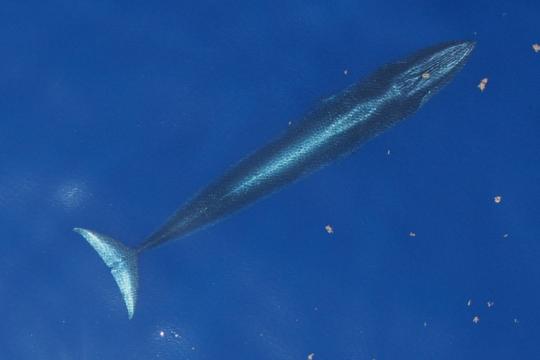 A Rice’s whale just under the surface of the water in the Gulf of Mexico. This endangered whale was recognized as a separate species from the Bryde’s whale in 2021. Credit: NOAA Fisheries under NOAA Permit No. 21938.
A Rice’s whale just under the surface of the water in the Gulf of Mexico. This endangered whale was recognized as a separate species from the Bryde’s whale in 2021. Credit: NOAA Fisheries under NOAA Permit No. 21938.
Celebrate Whale Week with Us: A Message from Janet Coit, Assistant Administrator of NOAA Fisheries
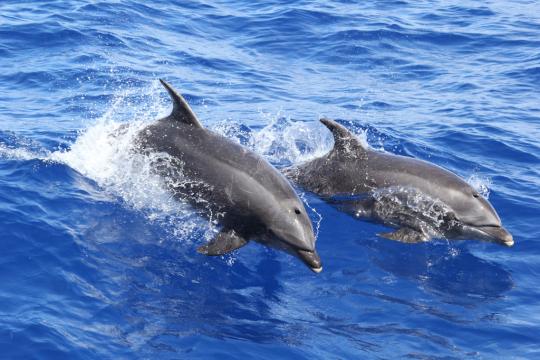 Pair of bottlenose dolphins. Credit: NOAA Pacific Islands Fisheries Science Center/Lisa Morse.
Pair of bottlenose dolphins. Credit: NOAA Pacific Islands Fisheries Science Center/Lisa Morse.
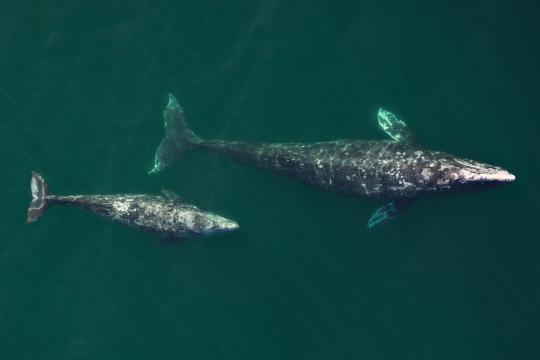 Gray whales were nearly hunted to extinction by commercial whaling. Protections under the MMPA, ESA, and the end of commercial whaling have allowed the species to recover. Credit: NOAA Fisheries (Permit #19091).
Gray whales were nearly hunted to extinction by commercial whaling. Protections under the MMPA, ESA, and the end of commercial whaling have allowed the species to recover. Credit: NOAA Fisheries (Permit #19091).
Celebrating 50 Years of the Marine Mammal Protection Act
Management Overview
The longman's beaked whale is protected throughout its range under the Marine Mammal Protection Act.
Additionally, the longman's beaked whale is listed under:
- Appendix II of the Convention on International Trade in Endangered Species of Wild Fauna and Flora (CITES)

Conservation Efforts
Reducing Interactions with Fishing Gear
Longman’s beaked whales have been caught as bycatch in fishing gear, such as in fisheries operating in Sri Lanka, leading to deaths and serious injuries.
Learn more about bycatch and fisheries interactions
Overseeing Marine Mammal Health and Stranding Response
We work with volunteer networks in all coastal states to respond to marine mammal strandings including all whales. When stranded animals are found alive, NOAA Fisheries and our partners assess the animal’s health and determine the best course of action. When stranded animals are found dead, our scientists work to understand and investigate the cause of death. Although the cause often remains unknown, scientists can sometimes attribute strandings to disease, harmful algal blooms, vessel strikes, fishing gear entanglements, pollution exposure, and underwater noise. Some strandings can serve as indicators of ocean health, giving insight into larger environmental issues that may also have implications for human health and welfare.
Learn more about the Marine Mammal Health and Stranding Response Program
Marine Mammal Unusual Mortality Events
Longman’s beaked whales have never been part of a declared unusual mortality event. Under the Marine Mammal Protection Act, an unusual mortality event is defined as "a stranding that is unexpected; involves a significant die-off of any marine mammal population; and demands immediate response." To understand the health of marine mammal populations, scientists study unusual mortality events.
Get information on active and past UMEs
Get an overview of marine mammal UMEs
Addressing Ocean Noise
Increasing evidence suggests that exposure to intense underwater sound in some settings may cause some whales to strand and ultimately die. NOAA Fisheries is investigating all aspects of acoustic communication and hearing in marine animals, as well as the effects of sound on beaked whale behavior and hearing. In 2018, we revised technical guidance for assessing the effects of human-caused sound on marine mammal hearing.
Regulatory History
Like all marine mammals, Longman’s beaked whales are protected under the MMPA.
Key Actions and Documents
Last updated by NOAA Fisheries on 01/14/2025
Science Overview
NOAA Fisheries conducts various research activities on the biology, behavior, and ecology of Longman's beaked whales. The results of this research are used to inform management decisions for this species.

Stock Assessments
Determining the population size of the Hawaiian stock of Longman’s beaked whales helps resource managers gauge the success of NOAA Fisheries’ conservation measures. Our scientists collect and present these data in annual stock assessment reports.
Shipboard Studies
NOAA Fisheries conducts research cruises to collect information on beaked whale stocks, such as habitat preferences and feeding ecology. For example, we estimate the abundance of Longman’s beaked whales in the Hawaiian Islands Exclusive Economic Zone using oceanic research vessels to perform line-transect surveys. Information from this research can be used in management actions to protect these animals.
Acoustic Science
Our research is also focused on acoustics—the physics of the properties of sound. We study the basic acoustic behavior of cetaceans and fish, mapping the acoustic environment and finding better ways to find cetaceans using acoustic technologies. Our acoustic research also assesses the degree to which human-caused activities are changing the underwater soundscape, how these changes may potentially impact marine animals in their acoustic habitat, and what measures can be taken to mitigate these potential impacts.
More Information
Recent Science Blogs
Last updated by NOAA Fisheries on 01/14/2025
Research
Killer Whale and Beaked Whale Posters
Art-Science Collaboration Celebrates the Diversity of Killer Whales and Beaked Whales from Around the World
Last updated by NOAA Fisheries on 01/14/2025

